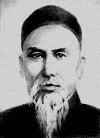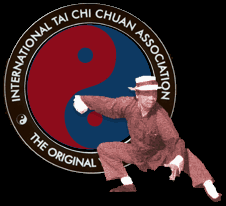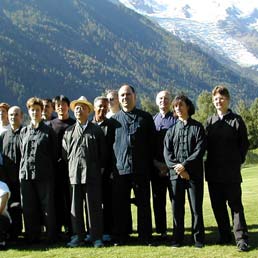| YANG
TAI CHI CHUAN
at the garden
All are invited to partecipate |
|
The Original Yang Style Tai Chi Chuan© is the evolution
into modern times of a process of refinement of Chinese martial
art that was begun in China by Master Chang San Fang circa
1300 AD. It has been said that Master Chang was a highly accomplished
boxer of his era, expert in Shaolin and Taoist fighting styles.
He had studied Taoist energy and spiritual cultivation techniques
in his maturity. Through his internal studies, and his deep
contemplation Master Chang arrived at the method by which
to apply energy technique to combat technique. As one contemporary
master has observed, Master Chang had built a very good bicycle
with his martial art; he was an efficient and competent fighter.
By adding Chi to his technique, he in a sense built a motorcycle.
Legend has it that in his observing a snake and crane fighting
in his courtyard Master Chang was inspired in his whittling
away everything non-essential from the arts he had practiced
and applied up until that time. Indeed, Yang Style Tai Chi
Chuan’s movements are based exclusively on the movements
of these two animals. Others assert that he and some companions
wished to devise the most devastating fighting technique known
combining their knowledge of martial arts, energy and acupuncture.
Regardless of what one wishes to believe, the fundamental
concepts of this art, the original name of which was surely
not Tai Chi Chuan, were passed on from Master to student until
they came to the hearing of Master Yang Lu Chan.
It is said that Master Yang Lu Chan (1780-1873) had first
studied Shaolin Hung boxing method from a very young age.
Legend has it that he had heard that a devastating and unique
form of boxing was the patrimony of the Master Chen Chang
Xin (1771-1853) of the Chen Village. The story goes that Master
Yang Lu Chan went to work for the Chen Family so that he could
learn from Master Chen. The latter held lessons in secret
and only around midnight, perhaps because he had studied with
Master Zhiang Fa. Master Zhiang Fa, a Taoist boxer, whose
art was directly descended from Master Chang San Fang, had
been passing through Chen Village and had seen Master Chen
Chang Xin practicing his family’s “Cannon Fist”
boxing technique, and could not help but laughing. This angered
Master Chen and he grabbed Master Zhiang Fa’s shoulder,
but was thrown to the ground simply upon the latter’s
turning round. Master Chen asked to learn from him and was
promised that in 3 years time Master Zhiang Fa would return
and teach him. So it came to be. The elders of the Chen Family,
then forbade Master Chen Chang Xin from teaching publicly.
Apparently this is why he would teach exclusively in his back
courtyard at midnight.
 Master Chan San Fang
Master Chan San Fang |

Master
Yang Lu Chan |

Master
Yang Chien Huo |

Master
Yang Chen Fu |

Master
Yang Sau Chun |
Young Yang Lu Chan would watch these lessons unnoticed through
a hole in the garden wall, and then would practice what he
had learned. One day, Master Chen discovered Yang Lu Chan
correcting the form of one of the former’s students.
Master Chen had Yang Lu Chan show him what he knew. Apparently
young Yang Lu Chan had learned the art better while studying
secretly than the normal students and so was formally accepted
as a student of Master Chen. He studied with the latter over
a thirty-year period. The great differences found between
Chen Tai Chi Chuan and Yang Tai Chi Chuan might be attributable
to the alleged direct instruction of Master Yang Lu Chan by
Master Zhiang Fa during that time.
Master Yang Lu Chan then went on to practice and develop his
new style of boxing, which still had not yet been named Tai
Chi Chuan. His art was so soft and yielding that people called
it “the style of the soft fist”, “mien quan”
(cotton boxing) or “hua quan” (neutralizing boxing),
or “the 13 postures”. However, later while in Peking,
he began to use the name Tai Chi Chuan thanks to a poet who
wrote that his form had the essence of the tai chi symbol
within it. It is said that in his extensive travels through
much of China he was challenged by the best boxers he encountered
and was never defeated, thus earning the title “Yang
the Invincible”. One important aspect of his high level
of development is that Master Yang Lu Chan is known to have
not ever seriously injured any of his defeated opponents.
He and his sons Master Yang Ban Huo (1837-1892) and Master
Yang Chien Huo (1842-1916) eventually became instructors of
the imperial court. Master Yang Chien Huo, also undefeated
in his career, had three sons: Master Yang Shao Huo (1862-1930),
Master Yang Chao-Yuan and Master Yang Chen Fu (1883-1936),
perhaps the most famous of the three.
Master Yang Chen Fu’s image is that most used in books,
brochures and descriptions of Yang Tai Chi Chuan. It was he
who developed and popularized the forms of Yang Tai Chi Chuan
that are most widely practiced today, in particular what is
known to some as the Peking form. His son, Master Yang Sau
Chung (1910-1985), one of the great masters of Tai Chi Chuan
of the middle and late 20th Century left his tradition to
3 disciples as well as to his children who were all women.
Furthermore, in 1953 Master Yang Sau Chung founded the International
Tai Chi Chuan Association (ITCCA) as a registered trademark
for the Original Yang Family Style of Tai Chi Chuan his disciples
promote.
 
Master Chu King Hung
Today Master Chu King Hung, direct disciple of Master Yang Sau
Chung, heads the ITCCA in Europe. Master Chu King Hung has steadfastly
maintained the traditions and teachings of Master Yang Sau Chung
while developing the diffusion of The ITCCA and the Original Yang
Style throughout Europe by way of an extensive travel and teaching
schedule as well as with the strong commitment shown by his disciples
and students.
The Original Yang Style is presented with a strong emphasis on
didactics, methodology and basic training. Explanations of the
techniques both in their outward forms and their more subtle manifestations
are clearly and frequently proffered in answer to even the most
pointed questions of the students. Not only is the theory of Tai
Chi Chuan as an expression of the tai-chi symbol and its Taoist
origins given but its martial implications are revealed for study
and practice as a regular part of many lessons as well. Nevertheless,
there are many people who are more interested in Tai Chi Chuan
for its health benefits rather than for any self -defense applications
that it offers.
The practice of this style has its roots in the Taoist arts from
Wu Dang Mountain, developed by Master Chang San Fang and later
by Master Yang Lu Chan. Its capacity for stimulating the inner
development of students is noteworthy even for beginners without
any previous formal training. New students often comment upon
how relaxed they feel after a lesson and how their personal energy
changes in the days that follow. Elderly practitioners note that
their joints begin to open as their general flexibility increases;
their breathing deepens to the point that tasks like climbing
stairs begin to no longer cause them to strain their breath. These
and other benefits, too numerous to mention here, are direct products
of the study and practice of The Original Yang Style Tai Chi Chuan.
The lessons allow students to develop their energy through the
practice of 24 Taoist energy enhancing exercises (sometimes called
Tao Yin), energy developing exercises called Chi Kung and energy
refining exercises called Yi Kung. These three brief sets of exercises
are integrated with the practice of the three-section Yang Style
form as described in many publications. Practice of two person
exercises such as pushing hands and small and large two person
practice sets, and the traditional weapons, sword, saber and staff
are also part of the ITCCA curriculum. What surprises all students
who come to this style is the width and breadth of the study as
well as its clear and well-defined organization. The Original
Yang Style Tai Chi Chuan of the ITCCA
is a true and effective example of the millennial evolution
of traditional Chinese self-development arts.

Stage at Chamonix whit
Master Chu King Hung
on the left Sifu Cedric Randolph |
|
 |
last update: feb 12 - 2004 |
|